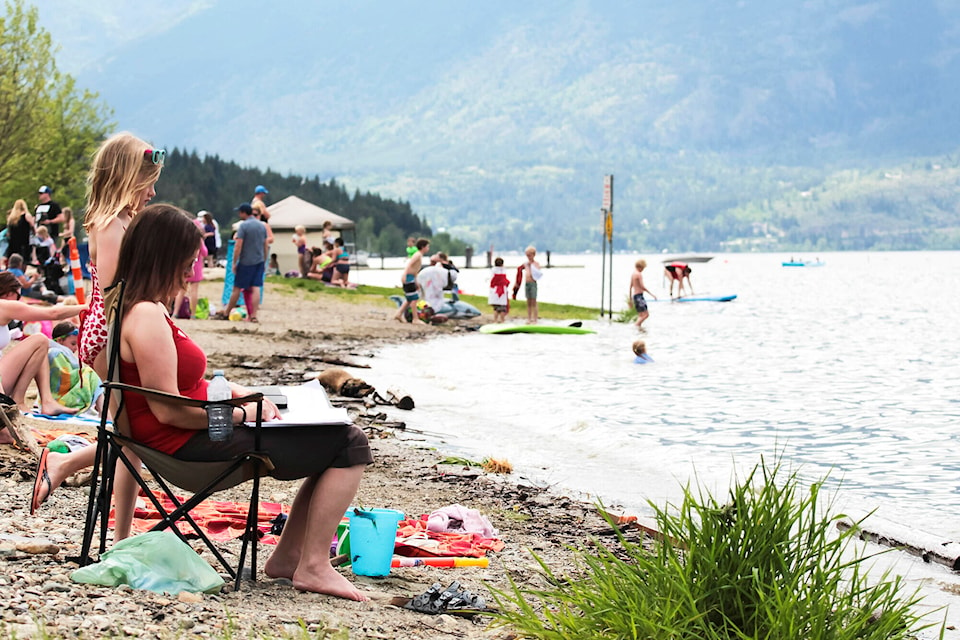With extreme heat scheduled throughout the week in Salmon Arm and area, places where people can take a cool break are being provided.
The SAFE Society is offering a temporary cooling centre at the Human Connection Hub on Shuswap Street by extending its regular hours.
The Hub will be open daily from noon to 5 p.m. on Monday to Friday, July 25 to 29, at 259 Shuswap St. NE in Salmon Arm, just down from the brightly coloured Innovation Centre.
Anyone is invited to drop in during those hours to browse the free store or relax in the air-conditioned space. Water and staff support will be available.
City of Salmon Arm facilities that will be open to the public include: the Shaw Centre from Monday to Friday, 8 a.m. to 5:30 p.m. and the SASCU Recreation Centre, Monday to Friday, 6:30 a.m. to 8:30 p.m. and Saturdays, 1 to 4 p.m.
The Shuswap Emergency Program (SEP) is assisting community partners in supporting vulnerable people in the area. If you, or anyone you know, needs assistance during the heat wave, call SEP at 250-832-2424.
The highs for Salmon Arm forecast by Environment Canada are: 34 C Tuesday, July 26; 36 C Wednesday; 37 C Thursday and Friday, 35 C on Saturday and 33 C Sunday, July 31. Nightime lows hover around 17 and 18 C.
Interior Health has provided information, much of it from the BC Centre for Disease Control, on staying cool and healthy.
Preparing for and responding to hot weather:
If you have air conditioning at home, make sure it is in good working order. If you do not:
• Find somewhere you can cool off. In addition to those listed above, consider places to spend time indoors such as libraries, movie theatres or malls. Also, as temperatures may be hotter inside than outside, consider outdoor spaces with lots of shade and running water.
• Shut windows and close blinds during the heat of the day. Open doors and windows when it is cooler outside to move that cooler air indoors.
• Ensure you have a working fan, but don’t rely on fans as your primary means of cooling. Fans can be used to draw cooler late-evening, overnight and early-morning air indoors. Keep track of temperatures in your home. Sustained indoor temperatures over 31 C can be dangerous for people who are susceptible to heat.
• If your home gets very hot, consider staying with a friend or relative who has air conditioning.
Identify people who may be at high risk for heat-related illness. Help them prepare for the heat. Monitor yourself, friends, neighbours and family. Consider developing a check-in system.
Ways to protect your health:
• Drink plenty of water and other liquids, even if you’re not thirsty.
• Spray your body with water, wear a damp shirt, take a cool shower or bath, or sit with part of your body in water to cool down.
• Take it easy, especially during the hottest hours.
• Stay in the shade and use sunscreen with SPF 30 or more.
• Take immediate action to cool down if you are overheating. Signs include feeling unwell, headache and dizziness. Overheating can lead to heat exhaustion and heat stroke.
• Signs of heat exhaustion include heavy sweating, severe headache, muscle cramps, extreme thirst and dark urine. If you are experiencing these symptoms, find a cooler environment, drink plenty of water, rest and use water to cool your body.
• Signs of heat stroke include loss of consciousness, disorientation, confusion, severe nausea or vomiting and very dark urine or no urine. Heat stroke is a medical emergency and you should call 911.
The public is asked to use 911 responsibly to avoid overwhelming the system.
When to call 911:
• In a case of heat stroke.
• In general, when there is chest pain, difficulty breathing, loss of consciousness, severe burns, choking, convulsions that are not stopping, a drowning, a severe allergic reaction, a head injury, signs of a stroke or a major trauma.
If you have a less urgent health issue, you can call HealthLinkBC at 811 and speak with a nurse.
Online tools are also available at healthlinkbc.ca, including a ‘Check Your Symptoms’ tool.
Read more: Vernon cools down with pop-up spray parks
Read more: Heat warnings issued across B.C. as highs threaten to hit 40 C
newsroom@saobserver.net
Like us on Facebook follow us on Twitter and subscribe to our daily newsletter.
